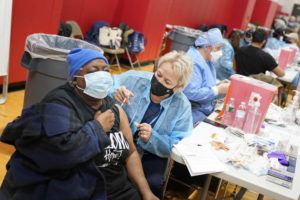Public health experts today blame the shortage of the COVID-19 vaccine in the United States, in part, for the Trump administration’s push to get states to expand their vaccination initiatives to reach the estimated 54 million people aged 65 and over.
The surge that began more than a week ago was not accompanied by sufficient doses to meet demand, according to state and local officials, leading to frustration and confusion and limiting states’ ability to attack the outbreak that killed more than 400,000 Americans.
In recent days, officials in California, Ohio, West Virginia, Florida and Hawaii have warned that their supplies are running low. New York City began canceling or postponing injections or stopped making new appointments because of the shortage, which President Joe Biden promised to reverse.
The vaccine’s launch so far has been “a huge disappointment,” said Dr. Eric Topol, head of the Scripps Research Translational Institute.
The problems started with the Trump administration’s “fatal error” of not asking for enough vaccine, which was purchased by other countries, Topol said. Then opening the line for the elderly confused people because there was not enough vaccine, he said. The Trump administration also left crucial planning to the states and failed to provide the necessary funding.
“It doesn’t happen with fairy dust,” said Topol. “You need to fund this.”
Last week, before Biden took office, the United States Department of Health and Human Services suggested that the frustration was the result of unrealistic expectations among states about the amount of vaccine on the way.
But some public health experts said that states have not obtained reliable information about vaccine deliveries and that the quantities shipped are unpredictable. This, in turn, made it difficult to plan how to vaccinate people.
“It’s a bit of having to build it as we go along,” said Dr. George Rutherford, an epidemiologist at the University of California, San Francisco. “It is an initial supply problem and, unless we know how much vaccine is flowing down the pipe, it is difficult to get these things the right size, form a team, get people there, vaccinate them and eliminate them.”
State health secretaries asked the Biden government for earlier and more reliable predictions about vaccine deliveries, said Washington State Health Secretary Dr. Umair Shah.
Dr. Marcus Plescia, of the Association of State and Territorial Health Officers, was also among those who said that the opening of vaccination to the elderly was done very early, before the offer could increase.
“We needed stable federal leadership at the start of the launch,” said Plescia. “This did not happen, and now that we are not prioritizing groups, there will be a delay for supply to keep up with demand.”
Supply will increase in the coming weeks, he said. Deliveries leave for the states every week, and the government and pharmaceutical companies have ensured that large quantities are on the way.
The launch took place at a disappointing pace. The United States government has distributed nearly 38 million doses of the vaccine to the states, and about 17.5 million of them have been administered, according to the Centers for Disease Control and Prevention.
About 2.4 million people received the two necessary doses, according to CDC accounts – well below the hundreds of millions that will have to be inoculated to beat the outbreak.
Biden, in one of his first business orders, today signed 10 executive orders to fight the coronavirus pandemic, including one expanding the use of the Defense Production Act to expand vaccine production. The 1950 Korean War-era law allows the government to direct the manufacture of essential goods.
He also ordered masks for travel, including at airports and planes, ships, trains, buses and public transport, and ordered the Federal Emergency Management Agency to create vaccination centers and the CDC to make vaccines available in pharmacies starting next month.
Biden promised to dispense 100 million doses in his first 100 days.
“We are going to move heaven and earth so that more people are vaccinated free of charge,” he said.
In New York, Mayor Bill de Blasio and Governor Andrew Cuomo have been begging for more doses. Appointments until Sunday for the first dose of the vaccine in 15 community vaccination centers set up by the city’s health department have been postponed until next week.
Vaccination in New York has not stopped, but vaccine demand now far exceeds the number of doses available, said the mayor.
“It is extremely sad to have so many people who want the vaccine and so much ability to give it, what is going on?” said de Blasio. “Due to lack of supply, we actually have to cancel appointments.”
Rosa Schneider seized the chance to make an appointment for a vaccination as soon as she heard that educators like her were eligible in New York. A high school English teacher who lives in New York City but works in New Jersey, she said that the day before she was vaccinated on Wednesday at a city hospital, she got a call saying the supply had run out and the consultation has been canceled.
“I was worried and upset,” said Schneider, 32, but she is trying to make another appointment daily. She expects availability to improve in the coming weeks.
